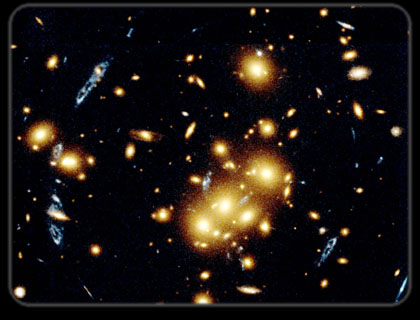Dark Matter
Dark Matter: Definition
- Dark matter is used to explain what we don't understand about kinematics
at large radii in galaxies and galaxy clusters. The amount of dark matter
is about 7 times that of ordinary matter.
- There are some scientists who think that our understanding of physics is
incorrect and that is the cause of "dark matter". However, most believe in
dark matter being an actual particle.
- Whatever it is, dark matter is an essential component of the Universe. It's
remarkable that we have been making models of the Universe without knowning
what over 90% of it is made up of.
- In our Solar System there is no need to invoke dark matter. When we measure
how fast the each planet is moving, we get exactly what we expect when we sum
over all of the mass. I.e., all of the mass is acounted for using Newtonian
dynamics.
- This is not true in a galaxy or in most galaxies. The easiest way to see this is
to use the rotation curve of galaxies.
- The gravitational force goes as the inverse of radius squared. So as you go
further away from a mass, the force decreases by the square of your distance.
Since the force goes down, the velocity goes down as well. However, when we look
at the rotation curves of galaxies, the rotational velocity does not decrease.
- But, in these galaxies, the amount of light (and hence visible mass) does decrease.
The only way to have the rotation curve not decrease is to add a lot of mass at
large radii. Since we don't see it, we call it dark matter.
- This effect is most easily seen in spiral galaxies, but the same is true for
elliptical galaxies. However, in elliptical galaxies, since they are not rotating
we must use different means to weigh them. So, we use the average speed (the sigma)
of the stars to do this.
- Whenever we encounter a situation which does not conform to Newtonian dynamics
we suspect that there is some mass there that we don't know about it. The exception
is on very small scales when there is a lot of mass: Einstein modified the equations
to take care of this situation since the Newtonian equations were incorrect.
- So, we must ask then on large scales do we have the same problem. I.e., we only see the
effect of dark matter at the largest radii, and since the equation were wrong
on one extreme, why not on the other. There are some groups which are looking into
this possibility, and even though it can't be ruled out yet, most scientists
accept the dark matter idea.
Dark Matter: History
- The first suspicion of dark matter came in the 1930s, when
Fritz Zwicky suggested
that clusters of galaxies contained dark matter. He used the average motion of the
galaxies in the cluster to measure the total mass, and found out that it was much
more than the number of galaxies.
- Zwicky turned out to be correct, but noone believed him since he had a reputation
of being eccentric and sometimes over-interpreting results. He found that galaxies
in the cluster represented less than 10% of the total cluster mass.
- Not until the 1960s did we find more evidence for dark matter.
Vera Rubin was
essentially responsible for this. She measured rotation curves in many spiral
galaxies.
- Over the next 20 years, she gathered many rotation curves and they all showed
evidence for a flattening at large radii. By the 1980s, most astronomers believed
that either gravity was wrong or that dark matter existed. This led to a re-evaluation
of Zwicky's work of the 1930s.
- Soon after that, many other clusters were studied and the same results found - a need
for dark matter.
- The evidence in galaxy clusters became much stronger due to two other observations:
hot x-ray gas, and gravitational lensing.
- The hot x-ray gas, or intracluster medium, had never been seen until x-ray telescopes
were pointed at clusters in the 1960s. The temperature of gas depends on the mass
of the cluster. The more mass, the hotter the gas is. Simple calculations can relate
the mass to the temperature. As the x-ray telescopes became better, we were able to
measure accurately the mass. Below is the Hydra cluster in x-rays and optical light:

- A more recent development is using gravitational lensing to measure mass. Below
is an image taken with HST that shows the effect from gravitational lensing:

- The red/yellow galaxies are all the cluster, but the blue images are really from one
galaxy that lies well behind the cluster and has been gravitationally lensed many
times. Here is another example of lensing.
- We know that the amount of bending is due to the amount of mass present. Thus,
we can measure the cluster mass by using the strength of the lens.
- For galaxy clusters, we have three independent ways to measure mass, and they all
give about the same result. Thus, that makes for a very compelling picture that
on cluster mass scales, we are seriously underestimating the total mass if we
only use the visible galaxies: DARK MATTER.
- Even more recently, we have a measure of the total mass content in the Universe.
When we compare this number to the amount of mass that we actually see, we again
find that we need to include dark matter. Thus, on levels beyond galaxies,
we have to invoke dark matter to explain the observations. The bottom line is
that over 90% of the Universe is in the form of something that we know very little about.

